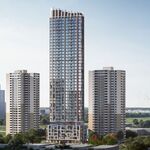Great idea. Looks a lot like Allen Road. How exactly are intersections handled?
But with Allen Road the roadway is depressed as well, meaning no at-grade connections to it. With Eglinton East the roadway would remain at-grade, but the LRT would be partially depressed in-median.
Intersections would be like normal for vehicular movements, but queue jump lanes for buses would be installed on all cross-streets that have a station (ex: Warden). The station would be located directly beneath the intersection, 1 level below grade. It would be side platform, and there would be 2 entrances to the station: one on the NW corner for the WB platform (handling SB bus passengers), and one on the SE corner handing the EB platform and NB bus passengers. The majority of the bus to LRT transfers will be SB to WB in the AM, and EB to NB in the PM, so this setup minimizes walking for most people.
The station entrances would be located in the island between the right turn lane and the straight thru lanes on the NW and SE sides of the intersection. There would be an elevator and stairs at either entrance, as well as a small bus waiting area. The queue jump lanes would allow buses to load and unload passengers without affecting traffic flow. If needed, 2nd stair only entrances can be located in the islands of the SW and NE parts of the intersection.
The platforms themselves would be half open air, half underground, with the underground portion being whatever is covered by the intersection. This would make ventilation and emergency exit requirements much easier, because half the station is open.
May sound a bit weird by description, but I've been meaning to do up a set of drawings of it for a while now, because I think this design could be applicable to almost any TC line where the line crosses a major intersection.





